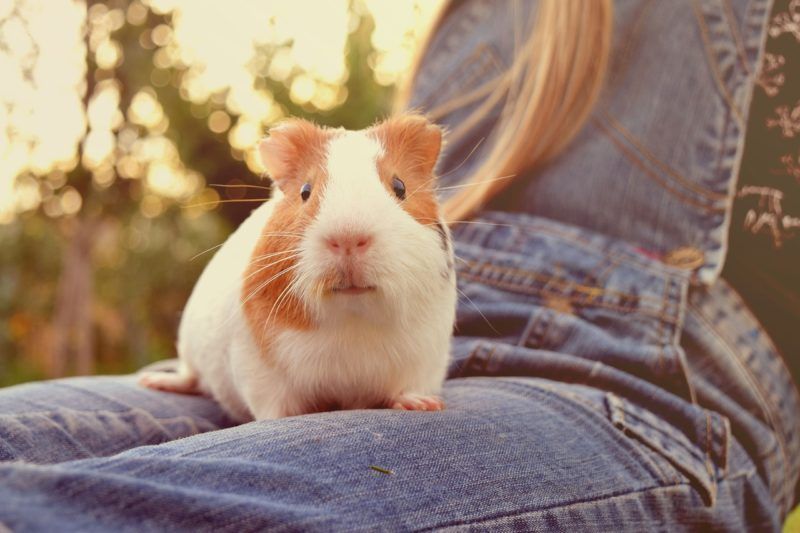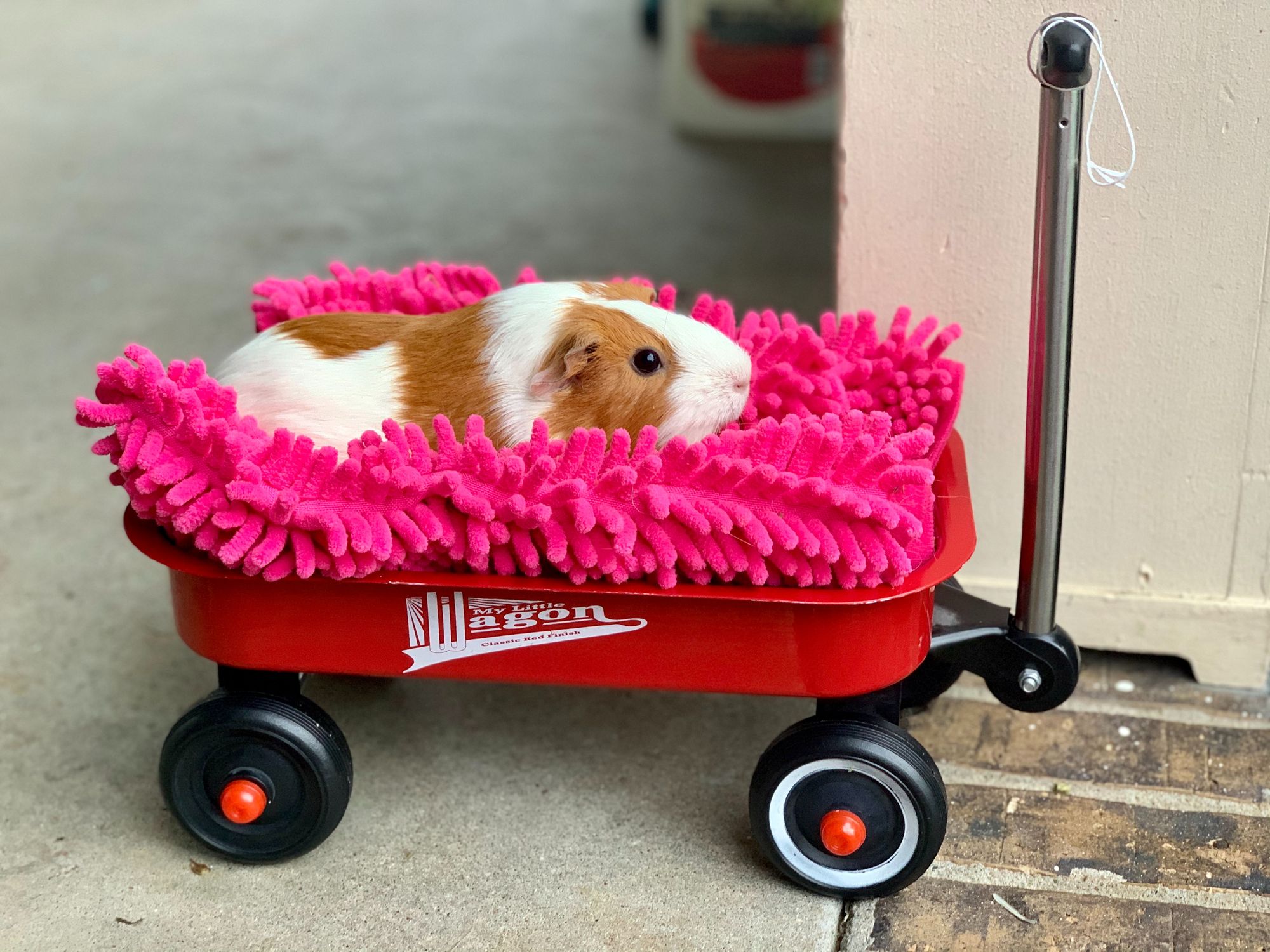How Long is Too Long For Your Piggie in a Guinea Pig Carrier?
We share some tips on how to make the travel safe and as comfortable as possible for you and your furry friend using guniea pig carrier!

Guinea pigs are wonderful furry creatures that can bring a lot of joy to your life. However, when you have to transport your guinea pig, it’s important to consider how long you should keep them in a carrier. It can be tempting to leave them in there for hours, espcecially if you have a long journey ahead, but this can be dangerous to their health. In this blog post, we'll explore how long is too long for your piggie in a guinea pig carrier and what factors you should consider when transporting them.
Traveling with your guinea pig can be an exciting but nerve-wracking experience. It’s natural to worry about the safety and comfort of your beloved pet, especially when you’re taking them in a carrier. But how long can a guinea pig be in a carrier before it becomes too much? Let’s take a closer look.
Introduction: Traveling with Your Guinea Pig
Traveling with your guinea pig can feel overwhelming, especially if it’s your first time. But with the right preparation and a guinea pig carrier designed for small pets, you can make the journey safe and comfortable for your furry friend. Guinea pigs have fragile bodies and need a pet carrier that offers both protection and comfort. Whether you choose a soft sided pet carrier or a sturdy hard shell, make sure it’s the right size for your guinea pig and the length of your trip. A well-designed carrier will help keep your guinea pig secure and cozy, making traveling a stress-free experience for both of you. Remember, the best experience comes from choosing a carrier that’s specifically made for small pets like guinea pigs, ensuring their safety every step of the way.
How Long Can A Guinea Pig Be In A Carrier?
The answer to this question depends on the age, size, and health of your guinea pig. As a general rule of thumb, adult guinea pigs should not be kept in carriers for more than 6-8 hours at a time. It’s important to make sure that the carrier is large enough for your pet to move around comfortably and has plenty of ventilation for air circulation. If possible, make frequent stops along the way to give your guinea pig some time out of their travel carrier.
It’s also important to note that younger guinea pigs should not be kept in carriers for extended periods of time as they are still growing and developing. You may want to limit their time in the carrier to no more than 4-5 hours at most if you need to take them on longer trips. It’s also important to make sure that the temperature inside the car stays consistent while they are traveling so that they don’t get too warm or too cold during their journey.
In addition, it is vital to ensure that the food and water supply is sufficient for your pet throughout their journey, as well as providing access to litter boxes whenever needed. These items should all be readily available so that you don’t have any problems when it comes time for your pet’s needs. Some carriers may leak if the ventilation holes extend to the base, so it's important to check for this feature to avoid messes during travel.
Make Regular Pit Stops
Long car rides can be uncomfortable and tiring for humans and animals alike, so make sure to take frequent breaks to stretch your legs and allow your guinea pig to get some fresh air and exercise. Find a safe and secure area where your guinea pig can explore and play for a bit. This will also give you an opportunity to check on your pet's well-being and clean up any messes in the carrier.
The key takeaway here is that while traveling with your guinea pig can be fun and stress-free, it's important to know how long they can spend in a carrier before things become uncomfortable or dangerous for them. Adult guinea pigs should generally not spend more than 6-8 hours at most in their travel carriers, whereas younger piggies should only stay in one for 4-5 hours maximum – if even that! Ultimately, it’s up to you as an owner to ensure that your pet is safe and comfortable during any kind of travel arrangement by making sure there is adequate space, food/water supply, litter box access (if applicable), and temperature control within the vehicle itself at all times!
Choose a Guinea Pig-Friendly Carrier
The first step to traveling with your guinea pig is choosing a carrier that is comfortable, secure, and appropriate for your pet’s needs. Look for carriers that are well-ventilated and spacious. Mesh panels are especially beneficial, as they provide excellent breathability and comfort for your guinea pig by allowing for optimal airflow. Make sure there is enough room for your guinea pig to move around, stretch out, and access food and water. Soft-sided carriers made of durable and breathable materials are usually a good choice, as they can be easily stored and transported. Hard-sided carriers, on the other hand, are often considered the safest option for travel due to their durability and superior protection. Additionally, make sure that the carrier is escape-proof and has a secure door, such as a front or top door, with a locking mechanism to enhance safety and ease of access. Security features like reinforced zippers or locks are important to prevent accidental openings and ensure your pet stays safe during transit. There are many small animal carriers available that are designed for guinea pigs, rabbits, ferrets, and other small pets, offering portability and convenience.

Find Guinea Pig-Friendly Accommodations
If you're planning to stay overnight on your trip, make sure to find accommodations that are guinea pig-friendly. Look for hotels that allow pets or consider renting a pet-friendly Airbnb. Additionally, make sure that the accommodations have enough space for your guinea pig to move around and feel comfortable. To ensure that your furry friend gets some exercise and fresh air during the trip, consider staying in a hotel or Airbnb with outdoor areas or nearby parks.
What is the price range for guinea pig carrier?
Prices listed by independent sellers for guinea pig carrier range from Under usd 20 to Over usd 100. It is up to you how much you want to invest in the safety, economy and comfort of your piggie or other small animal. Many guinea pig carriers are also suitable for other small pets such as rabbits, ferrets, and cats, making them a versatile choice for multi-pet households.
Adjust Your Guinea Pig's Diet
Traveling can be stressful for guinea pigs and small animals, so it’s important to keep their diet consistent to avoid any digestive issues. Stick to their usual diet of fresh hay, vegetables, and a small amount of pellets. Keep in mind that guinea pigs are prone to dehydration, so make sure they have access to plenty of fresh water throughout the trip. Offering small pieces of cucumber can also help keep your guinea pig hydrated due to its high water content. Avoid feeding your guinea pig any new or unfamiliar foods while traveling, as they may cause upset stomach.

Consider the Size of the Carrier
Carrier is the perfect solution for carrying your precious small pet safely and easily. When transporting your guinea pig, it’s important to consider the size of the carrier. If the carrier is too small, your guinea pig will not have enough space to move around and could become agitated, which can be stressful and dangerous to their health. On the other hand, a carrier that is too big might not give them enough support to prevent injury while you travel. Therefore, it's important to choose a carrier that is suitable for their size and provides enough space for them to move around comfortably.
Avoid Leaving Them in the Carrier for More than Two Hours
Just like humans, guinea pigs need regular breaks. They need to stretch their legs and have access to food and water. Therefore, it’s not recommended to leave them in the carrier for more than two hours. Even if you’ve provided food and water, they still need to move around to prevent cramping and stiffness. If you have a long journey, plan for breaks and take your guinea pig out of the carrier to stretch their legs, eat, and drink water.
Keep the Carrier Well-Ventilated
Guinea pigs need fresh air to breathe, especially when they're in an enclosed space. It's necessary to ensure that the carrier is well-ventilated, allowing air to circulate through the carrier. A well-ventilated carrier will help reduce stress, and it’ll also help prevent heat stroke, which can be fatal. Ensure that you don't cover the carrier with a blanket or any other item that can hinder the ventilation system.
Temperature Control: Keeping Your Piggie Comfortable
Guinea pigs are sensitive to temperature changes, so keeping their carrier at a comfortable temperature is essential during any trip. The ideal range for guinea pigs is between 65-75°F, so try to maintain this environment whether you’re traveling by car, train, or plane. If it’s chilly, you can add a cozy blanket inside the carrier, but avoid overheating by never placing the carrier in direct sunlight or near a heater. For warmer days, ensure the carrier has plenty of ventilation and consider using a frozen water bottle wrapped in a towel to help keep things cool. Some pet carriers are designed with special ventilation panels or insulated walls to help regulate temperature, keeping your guinea pig safe and comfortable. Always avoid sudden stops or drastic temperature changes, as these can stress your guinea pig and make traveling less enjoyable for your small pet.
Ensure That They are Snug and Safe
Your guinea pig needs to be safe and secure inside the carrier. Ensure that they can’t escape, get stuck, or move around excessively. Also, make sure that there is no loose bedding or anything that could be harmful to your guinea pig inside the carrier, particularly during travel. You want the carrier to be a comfortable and secure place. The carrier should feel like a safe home for your guinea pig during travel, helping them transition easily between travel and their usual living space. You can put a hideout or bed in larger carriers or travel cages to keep your guinea pig feeling secure but be careful not to block ventilation holes and monitor the temperature. Meje sure to monitor your guinea pig and take care to avoid temperature changes, direct sunlight and drafts.
Check on Your Guinea Pig Regularly
It's always a good idea to keep an eye on your guinea pig, even during short journeys. Since you can’t take them out of the carrier during travel, make sure that you check on them regularly to ensure that they’re comfortable and healthy. If you notice any signs of sickness or distress, take them out of the carrier immediately.
Hygiene and Cleaning: Keeping the Carrier Fresh
Keeping your guinea pig’s carrier clean is key to their health and comfort. Guinea pigs can be messy, so choose pet carriers with features like a removable liner or a machine washable interior to make cleaning easy. After each trip, simply remove the liner and toss it in the wash, or use a soft cloth to wipe down the inside of the carrier and remove any debris. Regular cleaning helps prevent odors and the buildup of bacteria, ensuring your guinea pig always has a fresh, safe space to travel in. Some carriers even come with handy accessories like replacement liners or cleaning kits, making maintenance a breeze. By keeping your carrier clean, you’ll help your guinea pig stay healthy and happy on every adventure.
Care and Maintenance of Your Guinea Pig Carrier
To keep your guinea pig carrier in top shape, always follow the care instructions provided by the manufacturer. Regularly check your carrier for signs of wear, such as frayed seams or broken zippers, and replace it if you notice any damage. Many pet carriers are designed for easy use, with features like a folding design for compact storage or a shoulder strap to help you easily carry your piggie to your next adventure. When not in use, store the carrier in a dry, secure place to protect it from moisture and pests. A little routine care will help your carrier last longer and keep your guinea pig safe and comfortable every time you travel.
Health Considerations When Traveling
Traveling can be a big change for guinea pigs, so it’s important to keep their health in mind. Make sure your carrier is guinea pig safe, with plenty of ventilation to prevent respiratory issues. Always bring a water bottle and some fresh hay to keep your guinea pig hydrated and comfortable during the trip. If your guinea pig has any health concerns, talk to your vet before you travel to get personalized advice. Not all airlines accept guinea pigs, so check their policies before booking your flight. With the right carrier and a little planning, you can help minimize stress and ensure your guinea pig stays healthy and happy on every trip.
Emergency Preparedness: Be Ready for the Unexpected
When you’re traveling with your guinea pig, it’s always smart to be prepared for anything. Pack a small emergency kit with essentials like a spare water bottle, a bag of hay, and a few basic first-aid supplies. Keep a list of important contacts, such as your vet and the nearest animal hospital, just in case you need help on the road. Some pet carriers are designed with safety in mind, featuring secure doors, sturdy handles, and reinforced sides to keep your guinea pig safe during sudden stops or unexpected bumps. By planning ahead and choosing a secure, guinea pig safe carrier, you can enjoy a stress free adventure with your small pet, knowing you’re ready for whatever comes your way.
Frequently Asked Questions about Guinea Pig Carriers & Travel Cages

1.2 What features should I look for in a guinea pig carrier?
Look for a carrier that is well-ventilated, sturdy, and easy to clean. Carriers with mesh panels provide excellent ventilation and visibility for your guinea pig. A secure door—whether front, side, or top—ensures easy access and safety. Security features such as reinforced zippers or locks are important to prevent accidental openings and keep your pet safe during transit. Make sure the carrier is the right size for your guinea pig to move comfortably.
1.3 Can I use a cat or small dog carrier for my guinea pig?
Yes, many cat and small dog carriers can be used for guinea pigs, as long as they are the right size and have proper ventilation. Some small animal carriers are also suitable for ferrets and rabbits. Small animal carriers are designed for a variety of pets, including guinea pigs, rabbits, ferrets, cats, and small dogs.
1.6 How do I keep the carrier clean and comfortable?
Line the carrier with soft bedding or a towel to keep your guinea pig comfortable. Clean the carrier regularly to prevent odors and bacteria buildup. Some carrier liners and accessories are machine wash safe for easy cleaning.
1.7 Can I travel with my guinea pig on a plane?
If you plan to fly with your guinea pig, always check the airline policies first, as not all airlines accept guinea pigs or other small pets like dogs. Each airline has its own rules regarding pet travel, so confirm requirements before booking your flight.
How long can a guinea pig be in a carrier?
Guinea pigs can typically be in a carrier for up to 4-6 hours, as long as they have access to food and water and are able to move around. However, it's recommended to take them out of the carrier every 2-3 hours for breaks and exercise.
What type of carrier is best for guinea pigs?
A sturdy and well-ventilated carrier is best for guinea pigs. It should be large enough for them to move around comfortably and have good airflow to prevent heat stroke. You can find soft-sided bag-style carriers, sturdy hard-shell cases and cage-style designs to help your guinea pig travel comfortably Soft-sided carriers may not provide enough protection for your guinea pig during travel. You can shop for travel carriers online or locally in your pet supplies stores.
Can I use a cat or small dog carrier for my guinea pig?
Cat, small dog, small animal carrier or hamster carrier can be used as long as they meet the requirements of a good guinea pig carrier. Make sure that they are secure, well-ventilated, and large enough for your guinea pig to move around comfortably.
What is a carrier for guinea pigs?
A carrier for guinea pigs is a container or cage specifically designed to transport guinea pigs safely and comfortably. It should be secure, well-ventilated, and large enough for the guinea pig to move around freely during travel. Carriers can be made of plastic, wire, or fabric materials. Some carriers may also have additional features such as food and water
How do you transport a guinea pig without a carrier?
Transporting a guinea pig without a carrier can be risky and should only be done in emergency situations. If possible, it's best to use a secure container such as a small cardboard box with air holes or a plastic bin with a lid. Make sure the container is large enough for your guinea pig to move around comfortably and line it with soft bedding. Always hold the container securely and avoid sudden movements while transporting your guinea pig. It's recommended to take them out of the carrier every 2-3 hours for breaks and exercise.
What should I put in my guinea pig’s carrier?
In addition to a comfortable bedding, you can also include some hay or vegetables for your guinea pig to munch on during travel. It's important to make sure the food won't spoil quickly and is securely contained within the carrier. You can also include a small water bottle or dish for your guinea pig to stay hydrated. Bringing along some familiar toys or a favorite blanket can also help your guinea pig feel more at ease during travel.

What are some tips for traveling with a guinea pig or small pets?
- Plan ahead and make sure you have all necessary supplies such as a carrier, food, water, and bedding.
- Familiarize your guinea pig with the carrier before the actual travel day to reduce stress and anxiety. Put either absorbent bedding, a puppy pad or guinea pig fleece in the carrier to absorb waste during long trips.
- Choose a carrier that is well-ventilated and has enough space for your guinea pig to move around comfortably. Some of pet carriers have shoulder strap to carry your piggie easily.
What is the best way to transport a guinea pig?
You can travel with guinea pigs, but you'll need to get a sturdy carrier or travel cage and monitor your guinea pig closely for signs of distress. The best way to transport a guinea pig is by using a secure carrier that provides enough space for your pet to move around and feel comfortable. Make sure the carrier is well-ventilated and has soft bedding for your guinea pig to rest on during travel. It's also important to handle the carrier with care and avoid sudden movements or loud noises that can startle your guinea pig. Lastly, taking breaks every 2-3 hours and providing opportunities for exercise can help make the journey more comfortable for your furry friend. So, be prepared and patient when traveling with your guinea pig to ensure a safe and stress-free trip for both you and your pet.
Can I hold 1 day old guinea pig?
It is not recommended to hold a 1 day old guinea pig as they are still very fragile and susceptible to injuries. It's best to wait until the guinea pig is at least 2 weeks old before handling them, as this allows them time to grow and develop stronger bones and muscles. Prioritize their safety and well-being by waiting until they are older before
Can I hold my guinea pig all day?
While guinea pigs enjoy social interaction and cuddling with their owners, it's important to give them breaks from being held. Holding your guinea pig all day can cause stress, discomfort, and even injuries for your pet. It's recommended to limit handling sessions to 10-15 minutes at a time and allow your guinea pig some time to rest in their own space. This will help maintain a healthy bond between you and your pet while also ensuring their physical and mental well-being. Additionally, providing plenty of opportunities for exercise and playtime outside of handling sessions can also benefit your guinea pig's overall health.
At the end...
Traveling with your guinea pig can be a fun and rewarding experience, but it requires careful planning and preparation. By following these tips, you can ensure that your furry friend is safe, comfortable, and happy throughout the trip. Remember to choose a guinea pig-friendly pet carrier, pack essential supplies, adjust your pet's diet, make regular pit stops, and find guinea pig-friendly accommodations. With a bit of effort and care, you and your guinea pig can embark on many adventures together!
Are you looking for a new guinea pig carrier? We have done all the research for you and put together our list of best guinea pig carriers you can buy today! Tap the link below to see the list now!

